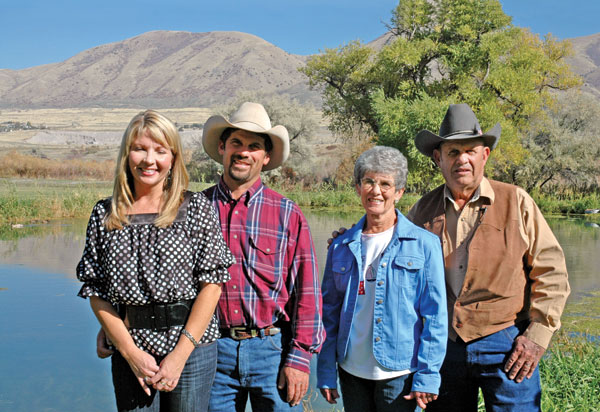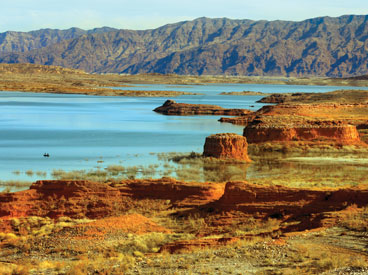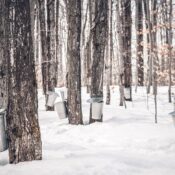In 2010 the research group Circle of Blue compared how much water residents of 23 U.S. cities consumed. The spread was ample, from 211 gallons per person daily in Fresno, California, to 41 gallons in Boston. Coming in second highest, at 180 gallons, was Salt Lake City. Drive around its neighborhoods and the reason becomes evident: Utah’s capital is a city of front lawns—mile after mile of lots covered with thirsty turf grass. Two-thirds of Utah’s residential water is used outdoors, according to the state’s Division of Water Resources, and in some counties the percentage is much higher.
Carving out paradise from the desert is a deeply rooted tradition. “The people that settled here came from places that were much wetter than Utah is,” says Eric Millis, the division’s deputy director. “They wanted to make things comfortable, and there was water available, so they put in lawns.” Other arid cities, like Tucson and Santa Fe, came to embrace the low-water landscaping technique called xeriscaping. But in Salt Lake City, along with the rest of Utah, big green yards “have endured as part of the culture,” Millis says.
Lawns are water hogs. “When you use water indoors, most of it goes down the drain, and it goes to a sewer system, and it goes to a treatment plant. Unless you’re in a coastal environment, that water is then put back in a stream and someone can use it again,” says Douglas Kenney, director of the Western Water Policy Program at the University of Colorado’s Natural Resources Law Center. “When you put water on your lawn, not only is it a lot of water, but that’s water that doesn’t come back in any way.”
If history and tradition encourage lush greenery, economics makes it possible. At the time of Circle of Blue’s survey, a family of four consuming 600 gallons a day paid $224 monthly in Santa Fe, $73 in Tucson, and $33 in Salt Lake City. That’s because Utah municipalities often subsidize residential water with property taxes. Millis says this system provides a steady, predictable income for water districts. But it also keeps user fees artificially low, masking the true cost of water. “The higher the price, the more people pay attention,” says the Pacific Institute’s Gleick, who notes that water bills are often lower than Internet and telephone bills. “If water is cheap and there’s no incentive to conserve, then people don’t conserve.” Some cities have built inducements into their rate structures: In Seattle and Tucson, for example, the price of a gallon rises steeply as consumption goes up. In Utah districts, not only is water inexpensive; its pricing also remains relatively flat, even for the most extravagant users.
Utah does encourage conservation, most notably through an educational program called “Slow the Flow.” And as farms have turned into subdivisions, some districts have acquired agricultural water to convert to municipal use. But Millis, the deputy director, says these measures alone won’t free up enough water to accommodate the Wasatch Front’s future growth. That’s why the state plans to spend $1.5 billion to dam and pipe water from the Bear River, the Great Salt Lake’s biggest tributary, by 2035. Millis says the state’s models show the project will cause only a minor drop in the lake’s levels. “It will suck the lake in some—more than you might expect,” he says. “But we believe that shorelines would adapt.”
Frankel of the Utah Rivers Council isn’t so sure. The Bear River is already expected to lose between 5 and 18 percent of its flow to climate change; funneling away even more to nourish suburban lawns could spell “the end of the West’s last great wetland ecosystem,” he says. Not only that: Damming the Bear could flood Northwestern Shoshone ancestral lands, as well as historic farms and ranches.
Frankel takes me to Tremonton, 75 miles north of Salt Lake City, where we meet three generations of a ranching family called the Selmans. Fred and Laura Selman, who are close to retirement age, live in a neat brick house overlooking the Bear River, on part of a 23,000-acre ranch that includes roaming grounds for 2,900 breeding ewes. (“Sheep are like gypsies,” Laura explains to me.) The Selmans, who also raise beef cattle, have been honored for their conservation practices: planting lines of trees called windbreaks, for example, which protect not only livestock but also wildlife and birds. “The land is a living thing,” says their 45-year-old son Bret. “Stewardship is a sacred calling.” Asked how often he thinks about conservation, Bret responds, “How often do you breathe?”

Even when grandson Cole went on his Mormon mission to Mexico, he couldn’t stop thinking about the land. Bret would send him text messages: Today we sheared the sheep; today we branded the calves; here’s a photo of a pine tree from the top of the mountain. Reading the messages, Cole would feel the sensation of hard work in his muscle memory and long to be home. Once, locating the ranch on Google Earth while in Mexico, Cole saw an aerial view of his family’s sheep on their twice-a-year migration across a certain footbridge. “You start getting all emotional,” says the 24-year-old.
Bret and I climb into his truck. In the late afternoon light, the mountains glow a pale orange. We drive past cylindrical bins filled with corn and barley, stacked bales of hay, and yearling calves sheltered by piles of snow. “Everything’s sleeping,” Bret says, just before a flock of Canada geese fly by. They circle and squawk before landing for the night. “They’re putting on a show for you,” he says. “I love watching them fall out of the sky like that.”
Losing this heritage is inconceivable to Bret. His family has been farming in Utah since the 1890s and fighting the Bear River Development since the 1990s, when a dam site was proposed that would have flooded the Selman’s 340-acre home ranch. That site was shelved—for the moment—and no one knows today whose land might be inundated. But it mystifies Bret that any productive farm or ranchland might be sacrificed before every other possible solution to the Wasatch Front’s water needs is explored. “So people can have green lawns, we give up agriculture? That doesn’t make sense to me,” he says. “Utah can’t feed itself now because of population increase and farmland losses. How much more ground do we want to lose?”
Ensuring enough water for a growing America will require everyone to pitch in. Farmers will need to reevaluate their crop choices and use more efficient irrigation technology. (Many have done so already.) Cities and suburbs will need to adopt rate structures that reflect water’s true cost and penalize inefficiency. They’ll also need to step up their education efforts.
There are plenty of models to follow. Some communities have created a buzz with xeriscaping contests that reward homeowners and professionals who design beautiful low-impact gardens. Others, such as San Diego and Las Vegas, offer rebates to residents who tear up their lawns and replace them with xeriscapes. Tucson reimburses residents who set up systems to harvest rainwater, and who irrigate their gardens with “gray water” recycled from bathtubs and clothes washers.
Tucson, which consumed residential water at about half the rate of Salt Lake City in the Circle of Blue survey, is a good example of what happens when a city collectively adopts a conservation ethic. “For many years, Tucson was entirely dependent upon a groundwater aquifer that was declining rather rapidly,” says Kenney of the Western Water Policy Program. “So Tucson has long been very fearful of running out of water. That created a culture where people just didn’t feel comfortable wasting water. If you put a lawn in your property in Tucson, you can expect some pushback from your neighbors.” That pushback rarely needs to happen: Newcomers usually see their neighbors’ desert landscapes and adjust automatically. “It’s very strange to drive through a neighborhood and see any lawn,” says Fernando Molina, a spokesman for Tucson Water. “People are proud of that as a community.”
Tucson has taken ownership of its water problems. That’s what Americans everywhere need to do: recognize that good decisions now can prevent economic and environmental upheaval down the road. Surviving the 21st century will mean changing how we all view and use water—treating it like the precious resource it has always been.
Become a Saturday Evening Post member and enjoy unlimited access. Subscribe now



